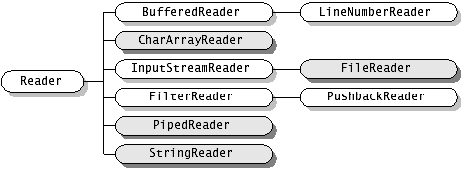【转】输入输出流(三)
上一篇 / 下一篇 2017-05-24 16:46:45 / 个人分类:Java
4.文件输出流:FileOutputStream类
作用:用来处理以文件作为数据输出目的数据流;或者说是从内存区读数据入文件 FileOutputStream类用来处理以文件作为数据输出目的数据流;一个表示文件名的字符串,也可以是File或FileDescriptor对象。
创建一个文件流对象有两种方法:
方式1:
File f=new File (“d:/myjava/write.txt ");
FileOutputStream out= new FileOutputStream (f);
方式2:
FileOutputStream ut=new FileOutputStream(“d:/myjava/write.txt ");
方式3:构造函数将 FileDescriptor()对象作为其参数。
FileDescriptor() fd=new FileDescriptor();
FileOutputStream f2=new FileOutputStream(fd);
方式4:构造函数将文件名作为其第一参数,将布尔值作为第二参数。
FileOutputStream f=new FileOutputStream("d:/abc.txt",true);
注意: (1)文件中写数据时,若文件已经存在,则覆盖存在的文件;(2)的读/写操作结束时,应调用close方法关闭流。
- import java.io.IOException;
- import java.io.FileOutputStream;
- public class TestFile {
- public static void main(String args[]) throws IOException {
- try {
- System.out.println("please Input from Keyboard");
- int count, n = 512;
- byte buffer[] = new byte[n];
- count = System.in.read(buffer);
- FileOutputStream wf = new FileOutputStream("d:/myjava/write.txt");
- wf.write(buffer, 0, count);
- wf.close(); // 当流写操作结束时,调用close方法关闭流。
- System.out.println("Save to the write.txt");
- } catch (IOException IOe) {
- System.out.println("File Write Error!");
- }
- }
- }
5. FileInputStream流和FileOutputStream的应用
- import java.io.File;
- import java.io.IOException;
- import java.io.FileOutputStream;
- import java.io.FileInputStream;
- public class TestFile {
- public static void main(String args[]) throws IOException {
- try {
- File inFile = new File("copy.java");
- File outFile = new File("copy2.java");
- FileInputStream finS = new FileInputStream(inFile);
- FileOutputStream foutS = new FileOutputStream(outFile);
- int c;
- while ((c = finS.read()) != -1) {
- foutS.write(c);
- }
- finS.close();
- foutS.close();
- } catch (IOException e) {
- System.err.println("FileStreamsTest: " + e);
- }
- }
- }
计算机访问外部设备非常耗时。访问外存的频率越高,造成CPU闲置的概率就越大。为了减少访问外存的次数,应该在一次对外设的访问中,读写更多的数据。为此,除了程序和流节点间交换数据必需的读写机制外,还应该增加缓冲机制。缓冲流就是每一个数据流分配一个缓冲区,一个缓冲区就是一个临时存储数据的内存。这样可以减少访问硬盘的次数,提高传输效率。
BufferedInputStream:当向缓冲流写入数据时候,数据先写到缓冲区,待缓冲区写满后,系统一次性将数据发送给输出设备。
BufferedOutputStream :当从向缓冲流读取数据时候,系统先从缓冲区读出数据,待缓冲区为空时,系统再从输入设备读取数据到缓冲区。
将BufferedInputStream与FileInputStream相接
FileInputStream in=new FileInputStream( “file1.txt ” );
BufferedInputStream bin=new BufferedInputStream( in);
2)将内存写入文件:
将BufferedOutputStream与 FileOutputStream相接
FileOutputStreamout=new FileOutputStream(“file1.txt”);
BufferedOutputStream bin=new BufferedInputStream(out);
3)键盘输入流读到内存
- import java.io.*;
- public class ReadWriteToFile {
- public static void main(String args[]) throws IOException {
- InputStreamReader sin = new InputStreamReader(System.in);
- BufferedReader bin = new BufferedReader(sin);
- FileWriter out = new FileWriter("myfile.txt");
- BufferedWriter bout = new BufferedWriter(out);
- String s;
- while ((s = bin.readLine()).length() > 0) {
- bout.write(s, 0, s.length());
- }
- }
- }
从键盘读入字符,并写入到文件中BufferedReader类的方法:String readLine()
作用:读一行字符串,以回车符为结束。
BufferedWriter类的方法:bout.write(String s,offset,len)
作用:从缓冲区将字符串s从offset开始,len长度的字符串写到某处。
Java中字符是采用Unicode标准,一个字符是16位,即一个字符使用两个字节来表示。为此,JAVA中引入了处理字符的流。
1. Reader抽象类
用于读取字符流的抽象类。子类必须实现的方法只有 read(char[], int, int) 和 close()。但是,多数子类将重写此处定义的一些方法,以提供更高的效率和/或其他功能。

1) FileReader :与FileInputStream对应
主要用来读取字符文件,使用缺省的字符编码,有三种构造函数:
(1)将文件名作为字符串 :FileReader f=new FileReader(“c:/temp.txt”);
(2)构造函数将File对象作为其参数。
File f=new file(“c:/temp.txt”);
FileReader f1=new FileReader(f);
(3) 构造函数将FileDescriptor对象作为参数
FileDescriptor() fd=new FileDescriptor()
FileReader f2=new FileReader(fd);
(1) 用指定字符数组作为参数:CharArrayReader(char[])
(2) 将字符数组作为输入流:CharArrayReader(char[], int, int)
读取字符串,构造函数如下: public StringReader(String s);
2) CharArrayReader:与ByteArrayInputStream对应
3) StringReader : 与StringBufferInputStream对应
4) InputStreamReader
从输入流读取字节,在将它们转换成字符:Public inputstreamReader(inputstream is);
5) FilterReader: 允许过滤字符流
protected filterReader(Reader r);
6) BufferReader :接受Reader对象作为参数,并对其添加字符缓冲器,使用readline()方法可以读取一行。
Public BufferReader(Reader r);
主要方法:
(1) public int read() throws IOException; //读取一个字符,返回值为读取的字符
(2) public int read(char cbuf[]) throws IOException; /*读取一系列字符到数组cbuf[]中,返回值为实际读取的字符的数量*/
(3) public abstract int read(char cbuf[],int off,int len) throws IOException;
/*读取len个字符,从数组cbuf[]的下标off处开始存放,返回值为实际读取的字符数量,该方法必须由子类实现*/
2. Writer抽象类
写入字符流的抽象类。子类必须实现的方法仅有 write(char[], int, int)、flush() 和 close()。但是,多数子类将重写此处定义的一些方法,以提供更高的效率和/或其他功能。 其子类如下:

1) FileWrite: 与FileOutputStream对应
将字符类型数据写入文件,使用缺省字符编码和缓冲器大小。
Public FileWrite(file f);
2) chararrayWrite:与ByteArrayOutputStream对应 ,将字符缓冲器用作输出。
Public CharArrayWrite();
3) PrintWrite:生成格式化输出
public PrintWriter(outputstream os);
4) filterWriter:用于写入过滤字符流
protected FilterWriter(Writer w);
5) PipedWriter:与PipedOutputStream对应
6) StringWriter:无与之对应的以字节为导向的stream
主要方法:
(1) public void write(int c) throws IOException; //将整型值c的低16位写入输出流
(2) public void write(char cbuf[]) throws IOException; //将字符数组cbuf[]写入输出流
(3) public abstract void write(char cbuf[],int off,int len) throws IOException; //将字符数组cbuf[]中的从索引为off的位置处开始的len个字符写入输出流
(4) public void write(String str) throws IOException; //将字符串str中的字符写入输出流
(5) public void write(String str,int off,int len) throws IOException; //将字符串str 中从索引off开始处的len个字符写入输出流
(6) flush( ) //刷空输出流,并输出所有被缓存的字节。
(7)close() 关闭流 public abstract void close() throws IOException
3 .InputStream与Reader差别 OutputStream与Writer差别
InputStream和OutputStream类处理的是字节流,数据流中的最小单位是字节(8个bit)
Reader与Writer处理的是字符流,在处理字符流时涉及了字符编码的转换问题
- import java.io.*;
- public class EncodeTest {
- private
TAG:
我的栏目
标题搜索
日历
|
|||||||||
| 日 | 一 | 二 | 三 | 四 | 五 | 六 | |||
| 1 | 2 | 3 | 4 | 5 | 6 | ||||
| 7 | 8 | 9 | 10 | 11 | 12 | 13 | |||
| 14 | 15 | 16 | 17 | 18 | 19 | 20 | |||
| 21 | 22 | 23 | 24 | 25 | 26 | 27 | |||
| 28 | 29 | 30 | |||||||
我的存档
数据统计
- 访问量: 126956
- 日志数: 167
- 建立时间: 2010-09-27
- 更新时间: 2019-03-09



